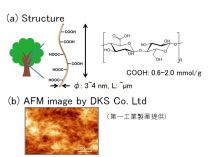Cellulose Nanofibers for Application in Regenerative Medicine ~ Fabrication of Engineered Tissues by Cell Culture in Thixotropic Gel ~

- researcher's name
- affiliation
- research field
-
Biomedical engineering/Biomaterial science and engineering,Polymer chemistry,Nanobioscience,Thin film/Surface and interfacial physical properties,Structural/Functional materials
- keyword
-
background
● Engineered tissues are useful in regenerative medicine and drug evaluation.
● 3D cell culture is promising for fabricating engineered tissues.
● Proper shaping of culture scaffold material, that is superior in cell retention and orientation control, is necessary.
● 3D cell culture is promising for fabricating engineered tissues.
● Proper shaping of culture scaffold material, that is superior in cell retention and orientation control, is necessary.
summary
● Cellulose nanofiber (CNF) hydrogel is used for cell culture scaffold (Fig. 1).
● Prepare coaxial two-layer long fibrous gel with microfluidic device (Fig. 2,3).
● Cells are embedded in the CNF gel of the core layer and 3D cultured to fabricate long muscle and vascular tissues (Fig. 2,4).
● Prepare coaxial two-layer long fibrous gel with microfluidic device (Fig. 2,3).
● Cells are embedded in the CNF gel of the core layer and 3D cultured to fabricate long muscle and vascular tissues (Fig. 2,4).
predominance
● CNF is plant-derived, highly biocompatible and superior in cell retention ability (Fig.4).
● Due to thixotropic property, CNF flows during pressurization in the device and gels at pressure relief after ejection, so it is easy to shape the scaffold into fibers (Fig.3).
● The CNF molecules themselves are aligned by pressure to orient the cells and induce engineered tissue formation efficiently.
● Due to thixotropic property, CNF flows during pressurization in the device and gels at pressure relief after ejection, so it is easy to shape the scaffold into fibers (Fig.3).
● The CNF molecules themselves are aligned by pressure to orient the cells and induce engineered tissue formation efficiently.
application/development
● Paper industry: Expansion of the CNF market to the biotech field.
● Medicinal industry: Production of regenerative tissues for therapy.
● Drug industry: Utilization of model tissues for drug evaluation.
● Medicinal industry: Production of regenerative tissues for therapy.
● Drug industry: Utilization of model tissues for drug evaluation.
material
same researcher's seeds
posted:
2018/11/28







